Originally published in COLUMBUS ALIVE

Whether mending a hem or making your own pizza, the pandemic has pushed many to hone practical skills at home, often at an accelerated pace. Remember how quickly folks went from baking sourdough to brewing their own beer?
But there are still some skills you can’t learn on Youtube, those that require a steady hand that only comes with experience, especially with arts quickly fading away amid advancing technology. So if blacksmithing is on your bucket list, Adlai Stein is your mentor for all things metal.
“I used to go to the Met in New York with my grandfather and look at the arms and armor. I loved history, but was also fascinated by Tolkien and tales of King Arthur,” Stein recalled. “That sense of adventure was always in my head, and I joined a medieval reenactment group called the Society for Creative Anachronism. That’s what got me started in blacksmithing, and I’ve been doing it ever since.”
The artistry of ancient weapons that captivated him as a child inspired the hobby that eventually overtook his occupation as a paralegal. Despite taking off his tie for the last time and picking up a hammer, it still took Stein years beforehand to master the tools and techniques to become a full-time blacksmith.
Classes at the Idea Foundry in Franklinton soon outgrew the space, so Stein relocated his studio, Macabee Metals, to a larger shop off of Central Avenue and started the Central Ohio School of Metalwork. In addition to private lessons, workshops have opened to door to those whose interest may be tempered by apprehension. From sand casting to railroad spike knives, everyone leaves with skills and an individual experience you won’t find elsewhere — and a finished memento forged with their own hands.
“The maker movement has really changed the perception of products that are made by hand, and the people who make them,” he noted. “Things that used to be viewed as inferior unless they were mass-produced are now in demand. People want to know how things are made, and who makes them.”
Blacksmithing was already enjoying a bit of renaissance even before the COVID crisis. The History Channel series Forged in Fire has emerged from cable television curiosity to become a top-rated show entering its eighth season. Stein competed himself in the third season, and later helped prepare another local contestant for the unforeseen challenges of the competition. He’s also been a featured speaker at TEDxColumbus, sharing his journey from artist to educator.
“Blacksmiths are such a tight-knit community of people, we’ll really don’t compete against one another. We’re all doing our own thing,” Stein explained. “You may go to a knife show where you know everyone there making handmade knives, but they’re all unique. It’s kind of like going to the Arnold [Sports Festival]. You don’t get mad because someone enjoys the same thing you do. It’s a chance to learn from one another.”
When you’re swinging a hammer and moving hot metal from a forge to an anvil, social distancing is second nature instead of an afterthought. Slowly shaping an abstract slab of steel into a purposeful profile, quenching the blade, then grinding and polishing it to a refined finish takes about four hours. But much like Forged in Fire, it’s time that goes by faster than you think. Beneath the controlled chaos there’s a sense of Zen to the entire process, equal parts art and science. What may have started as a one-time indulgence might just become your new favorite past-time.
Though Stein admits the perception of blacksmithing, somewhat perpetuated by the show, is “40-year-old white guys with beards”, interest doesn’t fit a predictable mold any more than two knives turn out exactly the same. Exhibitions at events like Summer Jam West cast a wide net, and his students for private and group classes have leaned decidedly younger and more diverse over time, some of whom are considering becoming blacksmiths themselves someday.
“I have 16-year-old girls who come in and kick ass, and 40-year-old men who get tired and walk out. Some people think it’s all about strength, when it’s really about accuracy and patience,” revealed Stein. “It takes someone who is fearless to be able to look at 1800 degrees of metal to say, ‘I going to move this with a hammer.’ It’s a different kind of strength, the strength of character.” ▩
For more on the Central Ohio School of Metalwork, including upcoming workshops, visit cosommetalwork.com